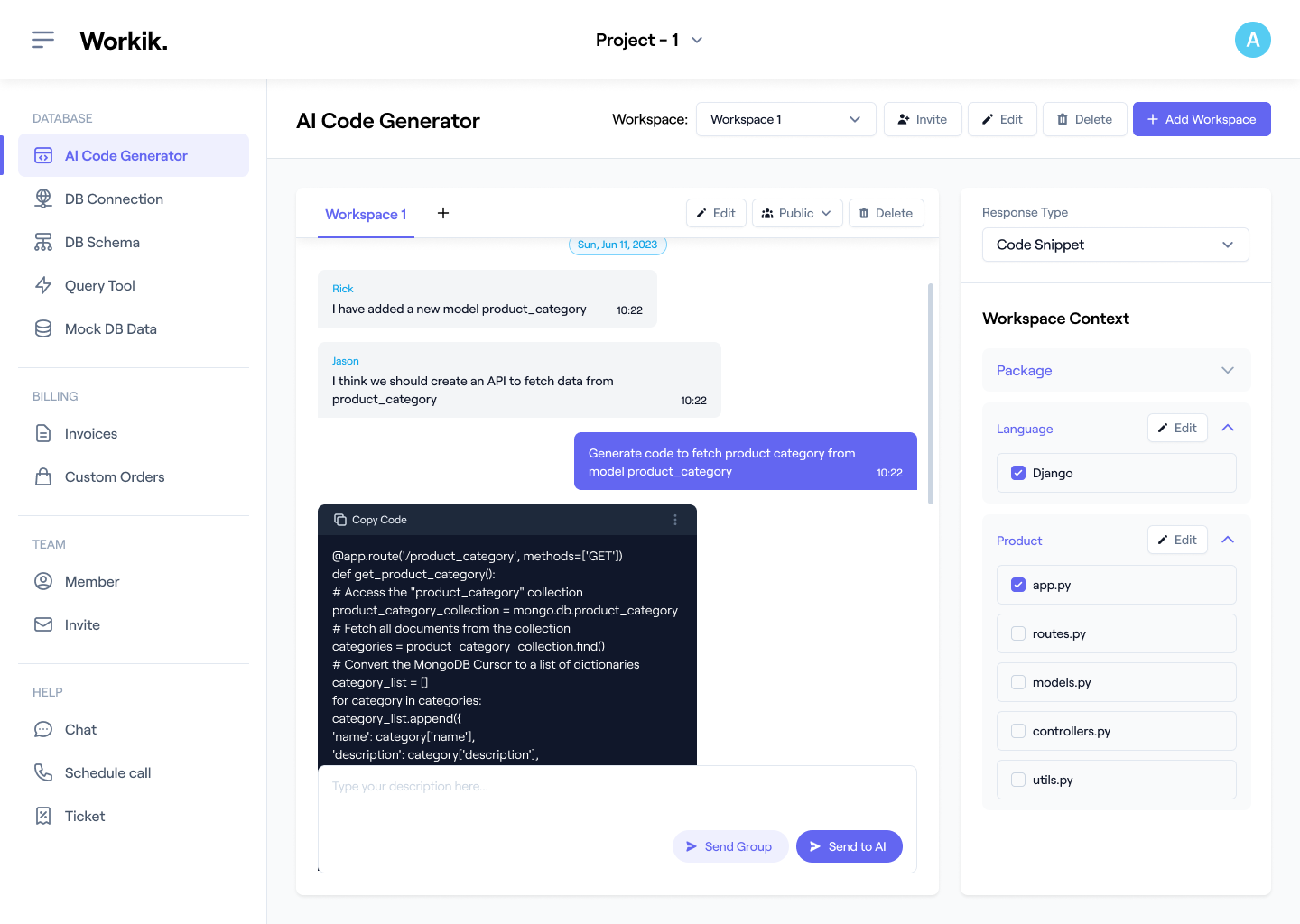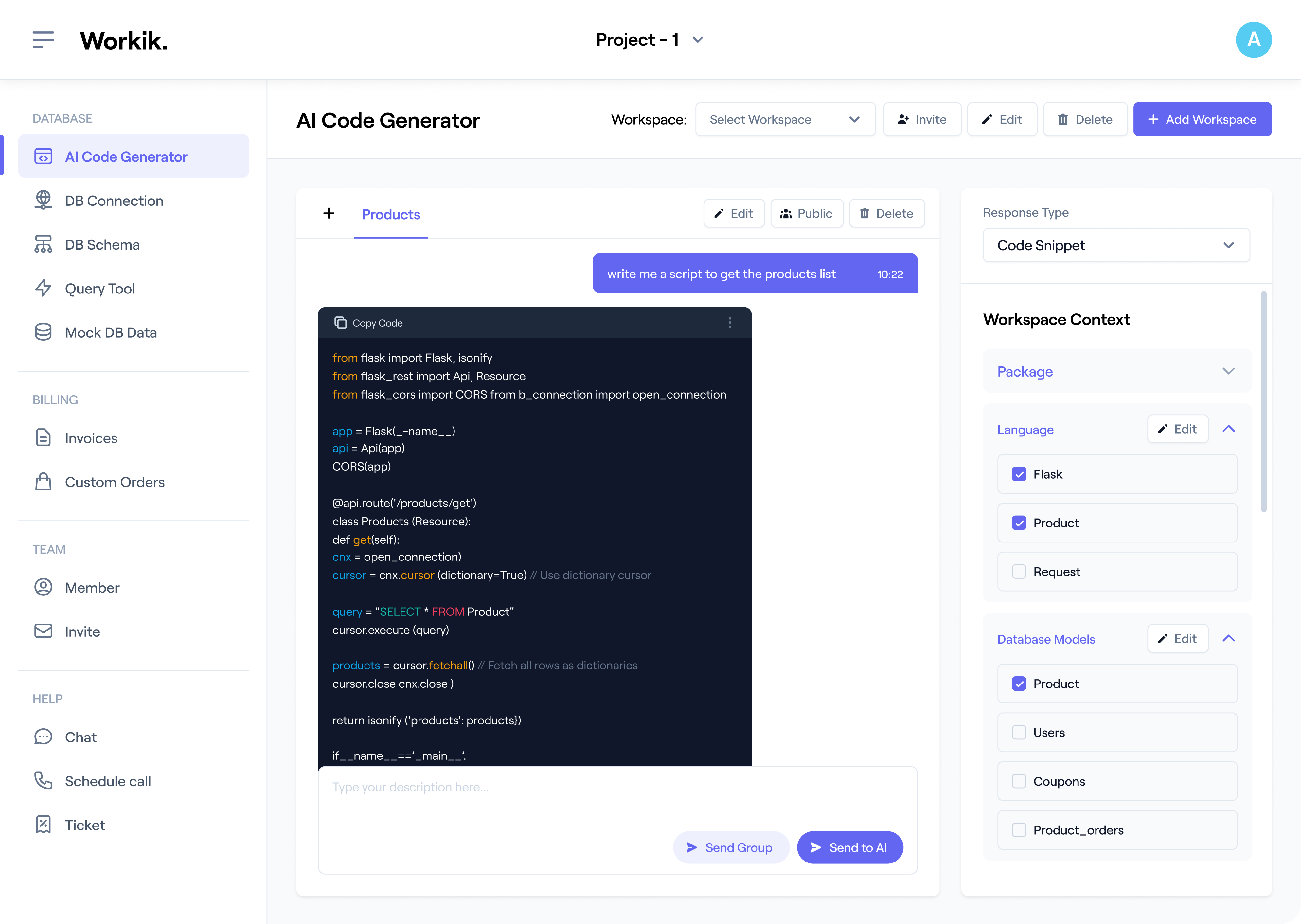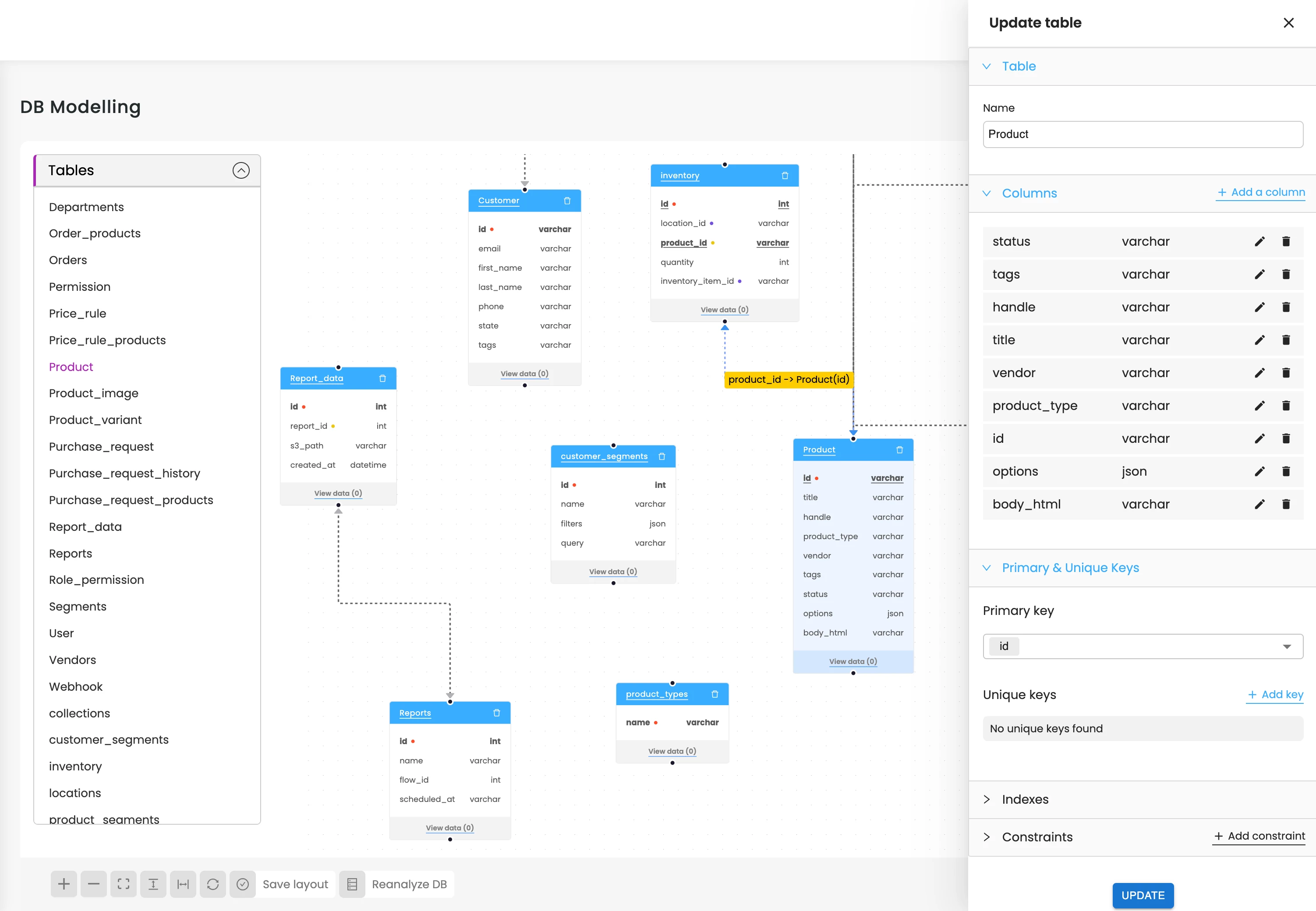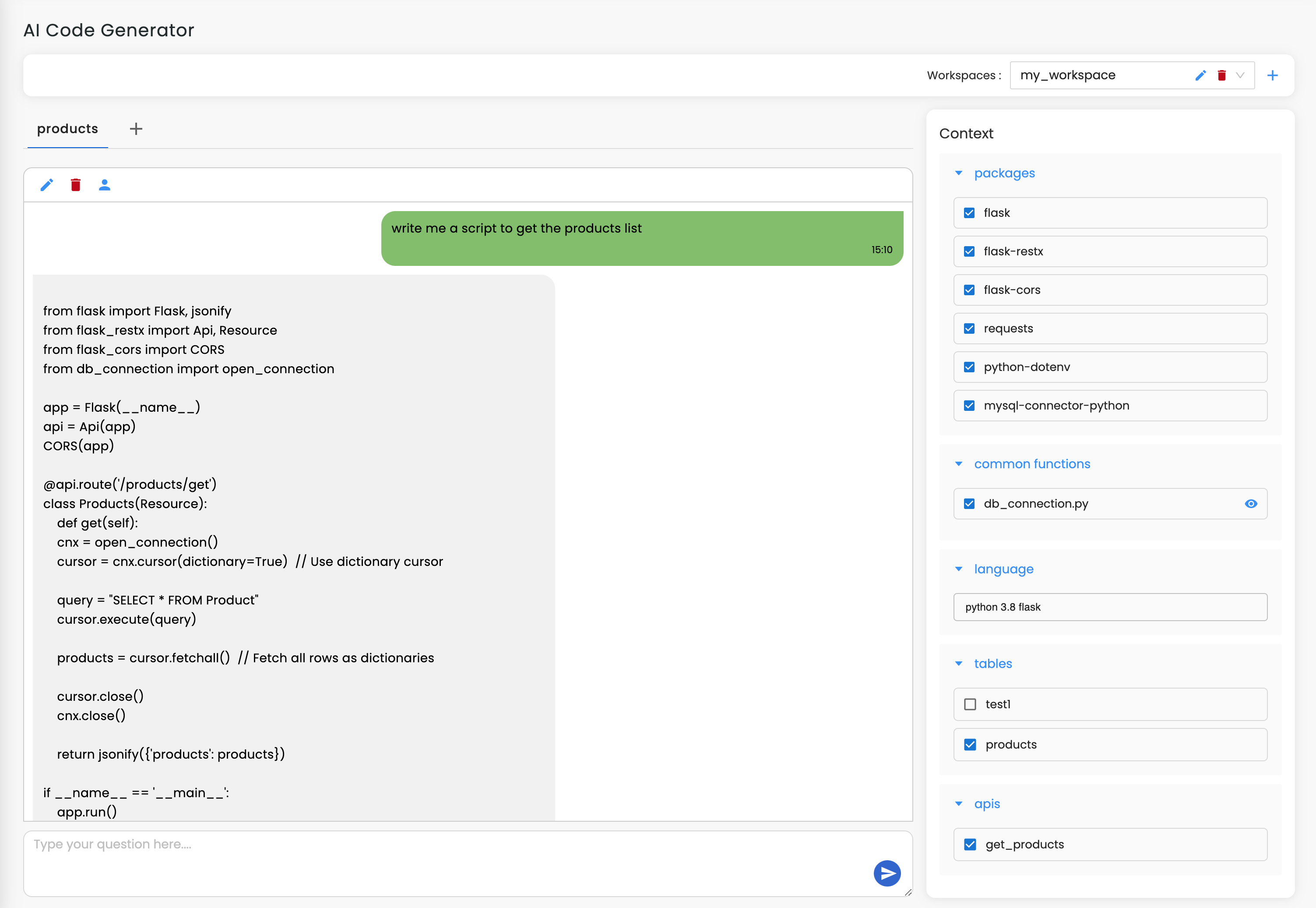Join our community to see how developers are using Workik AI everyday.
Supported AI models on Workik
GPT 5.2, GPT 5.1 Codex, GPT 5.1, GPT 5 Mini, GPT 5, GPT 4.1 Mini
Gemini 3 Flash, Gemini 3 Pro, Gemini 2.5 Pro, Gemini 2.5 Flash
Claude 4.5 Sonnet, Claude 4.5 Haiku, Claude 4 Sonnet, Claude 3.5 Haiku
Deepseek Reasoner, Deepseek Chat, Deepseek R1(High)
Grok 4.1 Fast, Grok 4, Grok Code Fast 1
Models availability might vary based on your plan on Workik
Features

Automate Development Pipelines
Use Workik AI to trigger builds, run tests, deploy apps, and send alerts from a single connected workflow.

Drag, Drop & Deploy
Design pipelines within minutes using a node-based interface by combining scripts, AI actions, and logic blocks.

Choose Any AI Model
Use any large language model (OpenAI, Gemini, Anthropic, etc.) to power your automations.

Use Prebuilt Templates
Start instantly with various ready-made automation templates for CI/CD, testing, alerts, reporting, and more.
How it works
Create your free Workik account and jump straight into building your first automation pipeline—no setup required.
Connect your automation triggers like GitHub, Slack, Gmail, Google Sheets, or use Webhooks and scheduled events. Workik AI supports integrations across cloud services, messaging apps, and dev platforms, so you can launch automations for whatever you need.
Drag, drop, and build any required pipeline with Workik AI’s visual automation builder. Add conditions, bots, scripts, and APIs and Workik AI will handle everything from running deploy scripts to sending alerts or posting updates on Slack.
Review and test your automation workflow. Collaborate with your team for real-time feedback.


Expand
.png)
.png)
Expand


Expand


Expand


Expand


Expand


Expand


TESTIMONIALS
Real Stories, Real Results with Workik
I use scheduled Workik AI bots to post cleaned database snapshots for daily database check. Saves hours every week.

Elena Garza
Backend Developer
Workik AI’s automations lets me trigger deployments, run tests, and notify the team, all from a single GitHub commit.

Priya Mehra
DevOps Engineer
I run all my deployments and tests right from Slack. It’s like having an AI-powered command line in chat.

Jordan Hayes
Frontend Lead
What are the most popular AI automation use cases for developers in Workik?


Developers use Workik AI for various types of automation. Some of the most popular use cases include but are not limited to:
1. Auto-running tests on GitHub commits and notify results in Slack
2. Triggering code formatting bots before PR merges
3. Generating and send daily build reports from Google Sheets data
4. Running post-deploy scripts and push updates to Discord
5. Cleaning up staging environments on a schedule
6. Auto-tagging Jira tickets based on Git commit messages
7. Reviewing pull requests with AI bots and post suggestions
8. Pinging stakeholders via Twilio/Gmail or Slack when deploys succeeds or fails
9. Parsing API responses and update central logs or dashboards
10. Triggering alert flows when errors are pushed to error-tracking tools
What kinds of integrations can I use in my automation workflows in Workik?


Workik AI supports a wide range of event-based triggers, and integrations allowing your automations to start instantly for any use-case. Some of them are:
1. GitHub: Trigger bots on PRs, commits, or branch merges
2. GitLab & Bitbucket: Start workflows on pushes or issue updates
3. Slack & Discord: Use slash commands to launch builds or run tests
4. Gmail: Automate responses or parse emails for action
5. Google Sheets: Trigger flows when rows are added or edited
6. Google Calendar: Automate tasks based on upcoming events
7. Webhooks: Connect external apps or services to fire workflows
8. Schedule: Run recurring tasks—daily builds, weekly reports, etc.
9. Telegram & Twilio: Trigger bots from messages for alerting
10. Asana, Jira, monday.com: Automate updates when tasks change
How can developers use AI automation in Workik for their development projects?


Workik AI helps automate dev workflows like CI testing, code formatting, post-deploy validation, or even generating reports. For instance, you can trigger a pipeline where one bot runs tests on a new PR, another formats the code, and a third posts the status update to Slack. You define the logic; Workik AI handles the rest saving hours on repetitive tasks.
Can I use Workik AI Automations for non-code based automations too?


Yes. While it’s built for dev teams, Workik AI automation supports tasks like updating spreadsheets, parsing input from forms, posting meeting summaries, or pinging stakeholders via e-mails. Developers also often use this to automate QA data validation, update Jira tickets, or ping clients when builds succeed.
Is it possible to reuse or clone automation workflows in Workik AI?


Yes, Workik AI lets you clone entire workflows with a single click. You can modify specific steps, update triggers, or swap out bots as needed. This is especially useful for teams managing similar pipelines across environments or replicating a tested setup for new projects—saving time and ensuring consistency.
Can I combine multiple triggers in one automation workflow?


Yes, Workik AI Automations allow you to set up multiple triggers within a single workflow. For example, you can configure a GitHub commit to trigger one branch of automation and a scheduled time-based trigger to start another. This flexibility helps you manage complex pipelines—like running nightly builds alongside event-driven actions—all within the same visual workflow.
Can I integrate Workik automation with my existing CI/CD pipeline?


Workik AI automations work seamlessly with CI/CD tools by triggering workflows on PRs, commits, or build completions via GitHub, GitLab, or Bitbucket. You can insert automation steps through Workik AI, like code reviews or post-deploy tests into your existing pipeline with minimal setup.
Can't find answer you are looking for?
Request question

Try for Free

AI Automation: Question and Answers
AI Automation refers to using artificial intelligence to streamline and execute repetitive or logic-based tasks without manual intervention. In software development, this includes things like running tests, reviewing code, triggering alerts, and managing deployments automatically.
Popular use cases of automation for developers include:
1. CI Workflow Automation –
Auto-run tests, format code, and validate PRs on every GitHub or GitLab event.
2. DevOps Alerts & Notifications –
Push build statuses, failures, or deploy alerts directly to Slack, Discord, or email.
3. Data Reporting –
Generate and send daily reports from tools like Google Sheets or external APIs—fully automated.
4. Environment Management –
Schedule cleanup scripts to reset staging or archive logs with zero manual effort.
5. API Monitoring –
Parse logs or error responses from APIs and route updates to dashboards or tracking tools.
6. Code Quality Checks –
Automate static analysis, linting, and code reviews via bots before merges.
Workik provides powerful tools for developers to automate repetitive tasks and streamline workflows with minimal effort:
1. Visual Automation workflow builder –
Create custom automation by dragging-and-dropping logic
2. AI-Bot chaining / AI Agent –
Connect multiple agents/bots to handle complex, multi-step processes
3. Python scripting support –
Insert custom scripts for added control and flexibility
4. Error Handling & Recovery –
Automatically retry failed steps or escalate errors
5. Real-time collaboration –
Share, review, and refine workflows with your team in one workspace
Explore more on Workik
Top Blogs on Workik
Get in touch
Don't miss any updates of our product.
© Workik Inc. 2025 All rights reserved.

